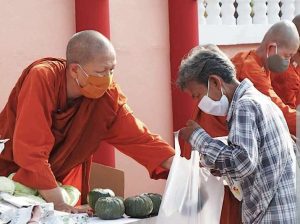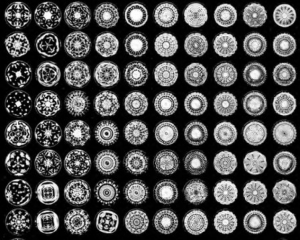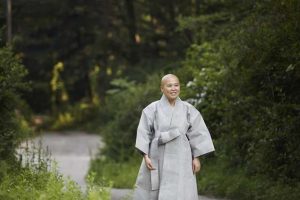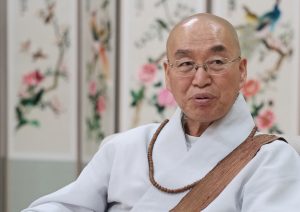
This two-part article is directly inspired by personal visits to Unmun-sa, a historic Buddhist monastery for female monastics in South Korea. These resulted from interacting and practicing with the lay sangha of Jungto Society, a volunteer-based Buddhist community founded the Korean Dharma master and social activist Venerable Pomnyun Sunim, and participation in the 18th Sakyadhita International Conference, held in Seoul from 23–27 June this year.
The first in-person Sakyadhita conference since 2019 because of the COVID-19 pandemic, the 2023 forum in Seoul was held under the theme “Living in a Precarious World: Impermanence, Resilience, Awakening”—the largest gathering in the history of Sakyadhita, jointly hosted by the Korean Bhikshuni Association and Sakyadhita Korea. More than 3,000 Buddhist monastics, laypeople, guests, and dignitaries from different countries and Buddhist traditions were in attendance, sharing their experiences and research, and providing support and encouragement for projects and initiatives to improve conditions for Buddhist women—especially those living in developing countries.
This short essay is part of a series that explores unique manifestation of the sacred feminine in contemporary Buddhism, by meeting and learning from some of the women who are working to shape the face of Buddhism today. Part two of this article will center on a candid conversation with members of Unmun-sa’s monastic community.
Women have played a prominent role in the history of Korean Buddhism, an influence that can be traced back to Buddhism’s advent on the Korean Peninsula in the fourth century during the Three Kingdoms period—a time of considerable political and social upheaval. Indeed, becoming a Buddhist monastic was a common life choice for social elites of the Silla kingdom (57 BCE–935 CE) and the Goryeo period (918 CE–1392).
Although the role of women in Korean Buddhist history was not well-documented, due to patriarchal biases in record-keeping, their influence has been an undeniable presence—for example, the world’s oldest extant book printed with movable metal type, the Jikji Simche Yojeol, or Anthology Teachings of Zen Buddhist Priests, written by the Buddhist monk Baegun (1298–1374), and dated to 1377,* references a female Buddhist monastic named Myodeok, thought to be a member of the royal family, who was instrumental in the book’s production at the historic Heungdeok-sa, an ancient Buddhist monastery in North Chungcheong Province.
In contemporary South Korea, female monastics remain an active force for progress and change within Korean Buddhism, despite an overall waning interest in spiritual traditions among wider society: according to survey data for 2021 compiled by the Gallup Korea Research Institute, a majority of South Korea’s population—60 per cent—holds no religious affiliation. Christians make up the largest religious segment of the population at 23 per cent, while Buddhists today account for 16 per cent.
Nevertheless, Korean bikkhshunis have played, and continue to play, a vital role in terms of the practice and propagation of Buddhism. Yet despite this undeniable contribution, most formal Buddhist institutions remain structurally patriarchal—a key factor hindering the development of Buddhism in contemporary Korea, falling out of step with a modern society that is evolving rapidly in the direction of greater gender equity, and out of step with the 2,600-year-old teachings of the Fourfold Sangha laid out by the historical Buddha, Shakyamuni.
One of the most striking manifestations of this sacred feminine in South Korea is found at Unmun-sa (Kr: 운문사) a historic Buddhist monastery in Cheongdo County of South Korea’s North Gyeongsang Province. Of the almost 6,000 bikkhshunis in South Korea, about a third have been educated at Unmun-sa Buddhist Nunnery University.
The monastery is propitiously nestled in the southernmost extent of the Taebaek Mountains, a rugged range of peaks that stretches more than 500 kilometers from the south of the peninsula and on up through to North Korea, like the sturdy backbone. Resting serenely among deep woodlands and protected by the gentle embrace of the surrounding mountains, Unmun-sa, which means “Cloud Gate Temple” in English, is administered by the Jogye Order of Korean Buddhism, South Korea’s largest Buddhist order, and is today the country’s foremost college and training center for female monastics.
It was originally constructed over a three-year period from 557–560 CE, and completed in the 21st year of the reign of King Jinheung (r. 540–576), who is remembered as one of the greatest monarchs of the Silla kingdom for a 37-year rule that laid the foundation for the later unification of the Korean Peninsula. Toward the end of the Silla period, the monastery was expanded and renamed Taejakgap-sa, or “Great Magpie Hillside Temple.” The name changed again to Unman-sa in 937 CE, during the 20th year of the reign of King Taejo (r. 918–943) of the Goryeo dynasty.
During the Goryeo period, Unmun-sa was bestowed a large amount of the surrounding land, which is today farmed by the bikkhshunis and student nuns to keep the monastic kitchen supplied with fresh vegetables.
Unmun-sa has been expanded and rebuilt throughout the centuries, taking on its present appearance through several stages of renovation and reconstruction. Today, it is filled with a plethora of historic buildings and exquisite architecture, and encircled by beautiful mountains, which the resident monastics compare to the gentle embrace of a sacred lotus flower. The resultant ambiance is perhaps unique, even among Korea’s many sacred mountain monasteries—possessing a spiritual energy that is at once calming and reassuring; a geo-energetic center of tranquility and safety.
Even the approach to the monastery prepares the visitor for the transition from the secular to the spiritual; following a meandering pathway that passes beneath an intricate arboreal canopy of interwoven branches and runs alongside the soothing Unmun-cheon River. Unmun-sa is particularly beautiful during the autumn months, as depicted in the accompanying images.
The monastery is home to numerous rare and valuable artifacts of special note and considered national treasures, including a stone lantern (Treasure No. 193), a stone pillar of the Four Protectors of Buddhism (Treasure No. 318), a three-story stone pagoda (Treasure No. 678), a bronze urn (Treasure No. 208), a seated stone Buddha (Treasure No. 317), and especially worthy of attention, a more-than-500-year-old weeping pine tree (Natural Monument No. 180).
Unmun-sa became modern Korea’s first school for bikkhshuni ordination in 1958 and is now the nation’s largest training center for fully ordained female monastics. With a capacity of roughly 260 bhikshunis, who study and practice according to a four-year term, Unmunsa Buddhist Nunnery University, founded by Ven. Myeongseong Sunim, 92, one of the first female Buddhist teachers in Korea, has produced more than 2,000 bikkhshunis since 1970.

In light of the tireless commitment, dedication, and verve of South Korea’s female monastic community, manifested in their personal practice, in their socially engaged activities, and in the global movement to fully re-establish the Fourfold Sangha, addressing the remaining barriers to gender equality within the monastic sangha is vital. Structural and institutional inequities merely serve to stifle female monastics in their efforts to contribute to the vitality of the Buddhadharma in South Korea and around the world and thereby appeal to the hearts and minds of new generations of lay practitioners and future members of the monastic community.
* Goryeo Kingdom Exhibition in Seoul Celebrates Korea’s Buddhist History (BDG)
See more
운문사 (Unmun-sa)
18th Sakyadhita International Conference: Living in a Precarious World: Impermanence, Resilience, Awakening
Sakyadhita International Association of Buddhist Women
Related features from BDG
Daughters of the Buddha: From Banking to Buddhism – A Conversation with Gelongma Pema Deki
Daughters of the Buddha: Progress on the Path of Female Ordination – A Conversation with Ven. Dhammananda Bhikkhuni
Daughters of the Buddha: Buddhism and Film with Ven. Daehae Sunim
Daughters of the Buddha: 18th Sakyadhita Conference in Seoul Celebrates the Sacred Feminine
From Bangladesh to Korea: Struggles and Successes on the Path to Female Monasticism
From Bhutan to Korea: Reflections of a Female Monastic on the Buddhist Path
Buddhistdoor View: Experiencing the Phase Shift – Women in Buddhism Today
Related news reports from BDG
Tibetan Nuns Project Announces a Record Number of Buddhist Nuns Taking Geshema Examinations in Dharamsala This Year
Living in a Precarious World: 18th Sakyadhita Conference Commences in Seoul
Engaged Buddhism: 20th Biennial INEB Conference Commences in South Korea
























